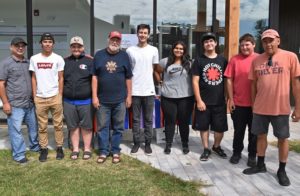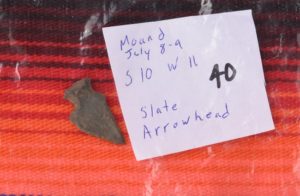Celebrating Nipissing First Nation youth protecting artifacts

By Kelly Anne Smith
NIPISSING FIRST NATION— The youth of Nipissing First Nation (NFN) are learning to be protectors of artifacts left behind by their ancestors.
They are students of the Nipissing First Nation Archaeology Field School. A special presentation was held August 18 celebrating the students and their discoveries made in 2019.
Glenn McLeod of Nipissing First Nation is the coordinator for the NFN Archaeology Field School. McLeod says the focus is on teaching students the skills required to become an archaeologist while also teaching about the history of the area.
“They do have the skills now to start digging. There are 20 students that have gone through the program that have the skills to be a liaison for Nipissing First Nation for any archaeological work.”
About 80 Nipissing First Nation citizens attended the celebration with feast of the Archaeology Field School’s extensive display of artifacts. The community is encouraging youth to be sleuths of the past.
Ten-year-old Chloe McLeod said she was on a walk when something caught her eye.
“I said, ‘Mom, look at this cool rock!’ My Dad said, ‘I think that’s an arrowhead.’”
The archaeology project has been conducted on Nipissing First Nation for ten years. The field school was started in 2013 with students learning skills from Archaeologist Ken Swayze, a consultant and Nipissing University adjunct professor.
This year’s big find was a mound that was previously undiscovered. The first week of the summer was spent excavating and analyzing the pre-contact site. The mysterious mound is 30-feet in diameter and about 3-feet off the ground.
Swayze says it’s a bit mysterious. In over 40 years of archaeology, he has never come across anything like it.
“Right away we could find some chert flakes and some other expedient stone tools. They’re definitely used by people because it’s not a natural feature. But what it is exactly, we don’t really know. It is not ceremonial. There are Nipissing mounds at LaVasse Portages but they are beehive-shaped low mounds and they are part of some ceremony. This is a flat top mound. It’s more like a platform. People definitely worked on the top of this platform because of the flakes and the stone tools they left behind. I’m wondering if it wasn’t for a special purpose.”

Parker Dalgliesh, a 17-year-old Grade 12 Chippewa Secondary School student, has participated in the field school for two summers. He really enjoys digging for the buried past.
When the students were excavating the mound, Parker found it to be in good condition.
“It’s crazy to see it is still there. And no one ever touched it.”
Parker imagines walking in his ancestors’ footsteps.
“Every step I take, I imagine where people have walked and where people have been.”
Swayze says there are many signs of the Nipissing People.
“People were everywhere on this lake. We looked at Beaucage Point where they built a village after the Robinson Treaty was signed. I wanted to go to Frank’s Bay because I know a lot of them came from Frank’s Bay to make this new village. I wanted to see if I could find cabin foundations that preceded Beaucage.”
Swayze points to the big metal pail found there.
“I found one foundation that the material predates the mill. I’m confident that foundation was from a Nipissing family.”
In the future, Swayze wants to explore Commanda Point. Paul Commanda was a well-known guide on Lake Nipissing. Swayze believes exploring Commanda’s old house on Beaucage Point could unearth some interesting finds.


